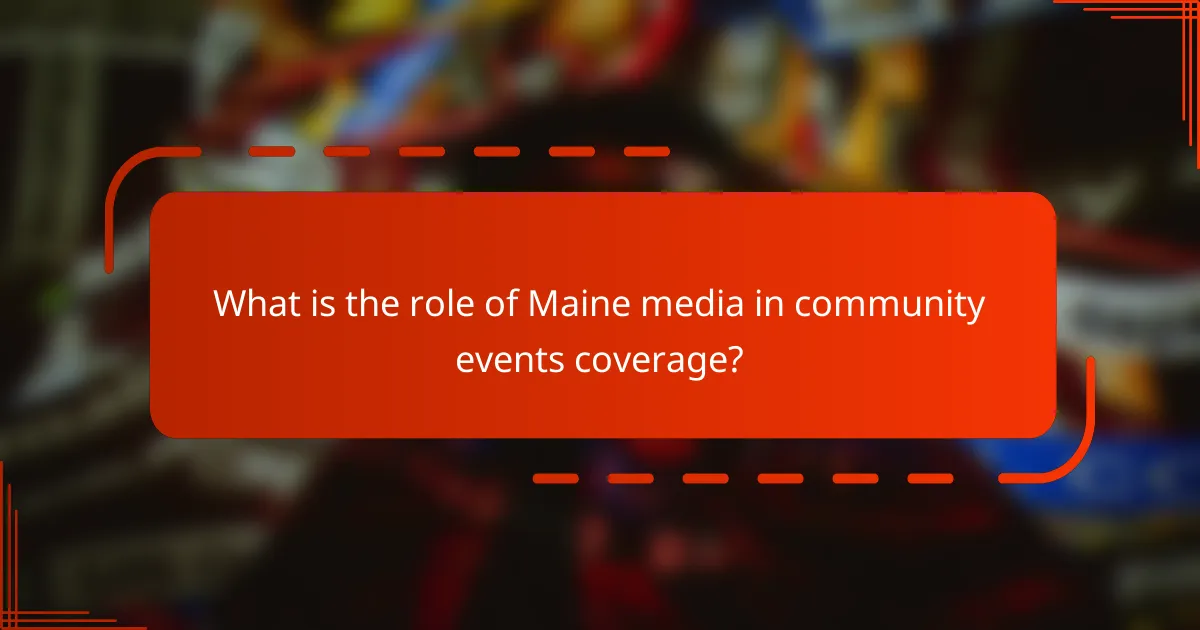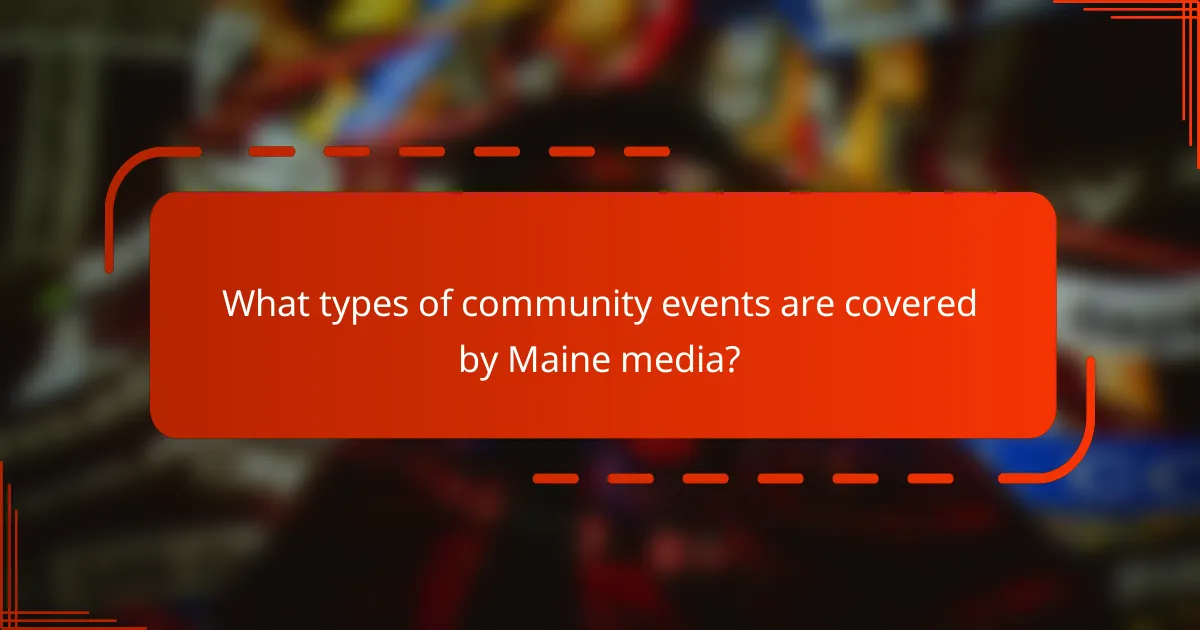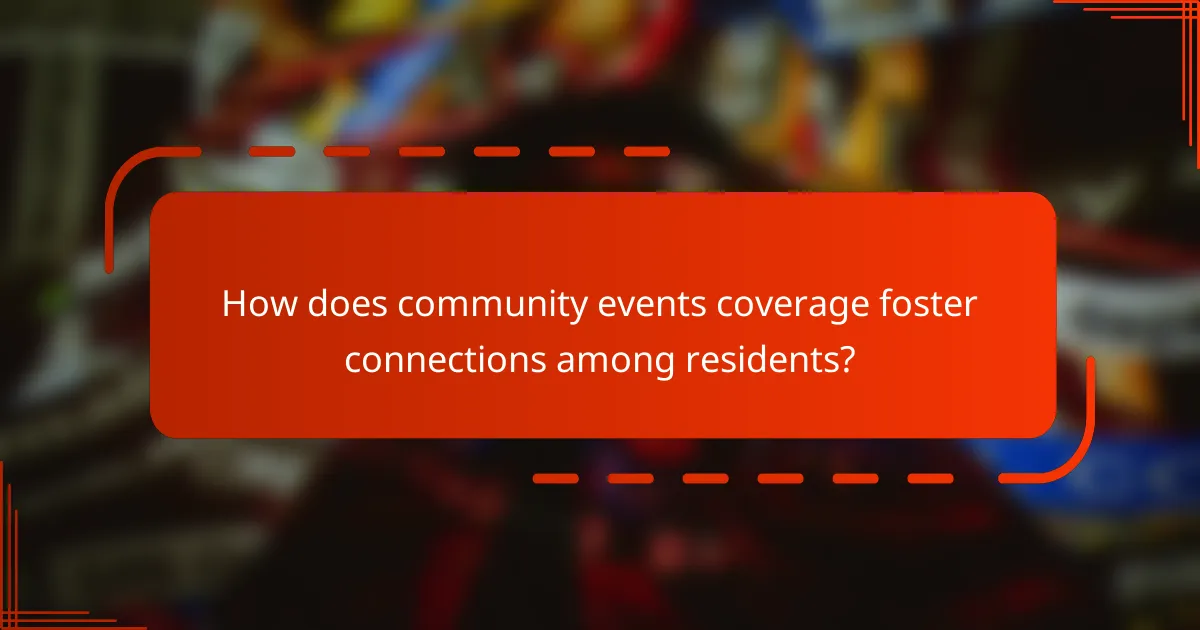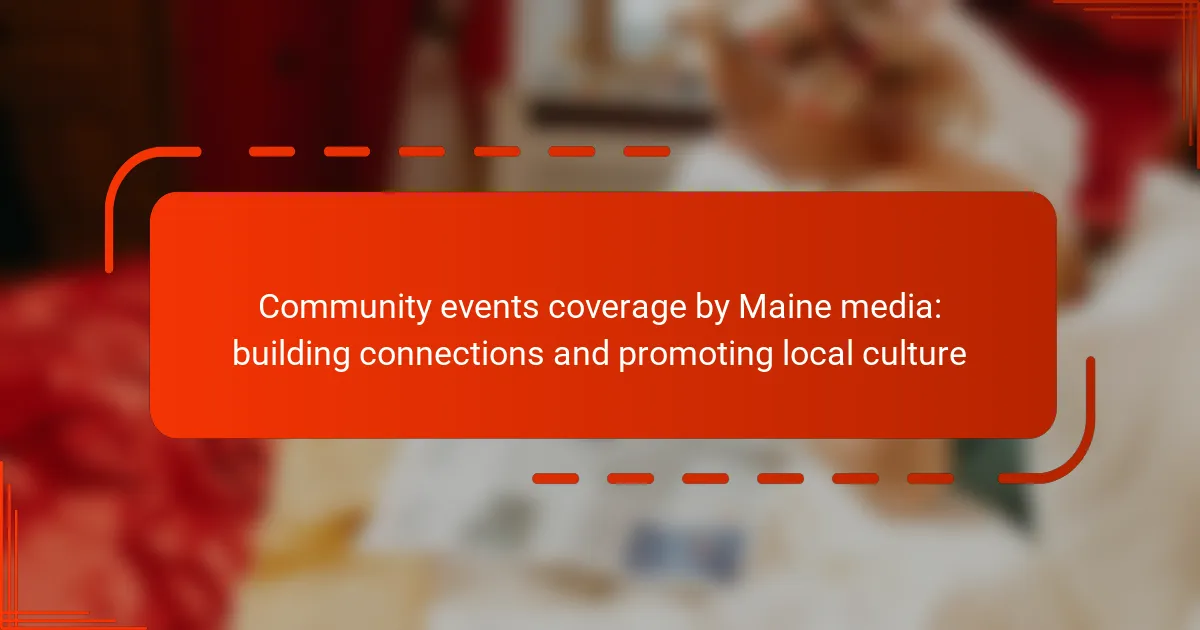Maine media serves as a vital source of information for local residents by covering a wide range of community events, including festivals, town meetings, and cultural celebrations. This coverage not only promotes local culture and traditions but also fosters community engagement and civic participation. Research indicates that local news significantly strengthens community ties by encouraging attendance and interaction among residents. Additionally, Maine media highlights local talent and initiatives, contributing to a sense of pride and belonging within the community. Overall, the reporting on community events plays an essential role in building connections and enhancing social cohesion among residents.

What is the role of Maine media in community events coverage?
Maine media plays a crucial role in covering community events. It serves as a primary source of information for local residents. Media outlets report on events ranging from festivals to town meetings. This coverage helps to foster community engagement and participation. Local news stories often highlight the significance of these events. They can also promote local culture and traditions. Research shows that community-oriented media increases civic involvement. For instance, a study by the Pew Research Center found that local news strengthens community ties. Thus, Maine media is essential in connecting residents with their community events.
How do Maine media outlets select which community events to cover?
Maine media outlets select community events to cover based on relevance to their audience. They consider factors such as local interest, event significance, and community impact. Outlets often prioritize events that foster community engagement and cultural promotion. Additionally, they assess the uniqueness of the event and its potential to attract public attention. Coverage decisions may also be influenced by partnerships with local organizations. The goal is to enhance community connections and support local culture. This approach aligns with the mission of many outlets to serve and reflect their communities accurately.
What criteria are used to determine the significance of an event?
Criteria used to determine the significance of an event include its impact on the community, historical relevance, and media coverage. Events that foster community engagement or address local issues are often deemed significant. Historical relevance can enhance an event’s importance, especially if it commemorates key local milestones. Media coverage amplifies an event’s reach, influencing public perception of its significance. For instance, events reported widely in local media tend to be viewed as more significant by the community.
How does audience engagement influence coverage decisions?
Audience engagement significantly influences coverage decisions in media. High levels of audience engagement indicate strong interest in specific topics. Media outlets often prioritize coverage of events that attract audience interaction. This engagement can manifest through social media shares, comments, and attendance at events.
For example, if a community event receives considerable online buzz, media may allocate more resources to cover it. Research shows that stories with higher audience engagement tend to have better reach and impact. Consequently, media organizations often analyze engagement metrics to guide their editorial choices. Engaging content can lead to increased viewership and advertising revenue. Therefore, audience engagement directly shapes what events and stories are prioritized in coverage.
Why is community events coverage important for local culture?
Community events coverage is essential for local culture because it fosters community engagement and connection. It provides visibility to local traditions, celebrations, and issues that matter to residents. Coverage of these events helps preserve cultural heritage by documenting and sharing unique local practices. Additionally, it promotes inclusivity by highlighting diverse voices and perspectives within the community. Studies show that communities with strong event coverage experience higher civic participation and social cohesion. For example, local newspapers reporting on town festivals can increase attendance and participation, strengthening community bonds.
How does coverage contribute to community identity?
Coverage contributes to community identity by highlighting local events and shared experiences. It fosters a sense of belonging among residents. When media covers community events, it showcases the culture and values of the area. This representation helps residents connect with their heritage and each other. Studies show that local media coverage increases civic engagement. For instance, communities with robust media presence report higher participation in local events. Coverage also amplifies diverse voices within the community. This inclusivity strengthens the overall community identity by reflecting its multifaceted nature.
In what ways does media representation shape public perception of local events?
Media representation significantly shapes public perception of local events by influencing awareness and interpretation. Local media coverage highlights specific events, which can increase community engagement. For instance, coverage of a local festival can attract more attendees by showcasing its significance and activities. The tone and framing of the coverage can also affect public sentiment. Positive portrayals can foster pride and participation, while negative coverage may lead to skepticism or disengagement. Research indicates that consistent media representation builds familiarity and trust within the community. Studies show that communities with robust media coverage of local events tend to have higher participation rates.

What types of community events are covered by Maine media?
Maine media covers a variety of community events. These include local festivals, farmers’ markets, and art exhibitions. They also report on parades, charity runs, and cultural celebrations. Seasonal events like summer fairs and winter sports competitions are highlighted as well. Additionally, Maine media features town hall meetings and public forums. Community events related to education, such as school plays and graduations, are also included. Coverage extends to environmental initiatives and conservation events. This breadth of reporting fosters community engagement and promotes local culture.
How do different media formats approach event coverage?
Different media formats approach event coverage through distinct methods and techniques. Print media often provides in-depth articles with detailed analysis and background information. Broadcast media, such as television and radio, focuses on real-time reporting and visual storytelling. Digital media utilizes social media platforms for immediate updates and audience interaction. Each format tailors its coverage style to engage its specific audience effectively. For example, print may include interviews and features, while digital platforms prioritize shareable content and multimedia elements. This diversity in approach enhances community engagement and promotes local culture effectively.
What are the distinctions between print, digital, and broadcast coverage?
Print coverage involves physical publications such as newspapers and magazines. It provides in-depth articles and visuals but lacks immediacy. Digital coverage includes online articles, social media, and blogs. It allows for real-time updates and interactive content. Broadcast coverage encompasses television and radio. It delivers news through audio-visual means, reaching a wide audience quickly. Each format has unique strengths. Print offers permanence, digital provides immediacy, and broadcast ensures broad reach. These distinctions affect how community events are reported and consumed.
How does the audience’s demographic influence the type of events reported?
The audience’s demographic significantly influences the type of events reported by media. Media outlets tailor their coverage to match the interests and needs of their specific audience demographics. For instance, younger audiences may prefer coverage of music festivals and tech events. In contrast, older demographics might be more interested in community gatherings and cultural heritage events.
Additionally, socioeconomic status affects the types of events highlighted. Communities with higher income levels may see more coverage of upscale events, while lower-income communities might focus on affordable local activities. Ethnic and cultural backgrounds also shape reporting, as media may prioritize events that resonate with the predominant cultural groups in their audience.
Research indicates that local media often reflect the values and preferences of their audience to maintain engagement. For example, a study by the Pew Research Center found that media coverage is often aligned with the cultural interests of the community it serves. This alignment ensures that the reported events foster community connection and reflect local culture.
What are some notable community events highlighted in Maine media?
Notable community events highlighted in Maine media include the Common Ground Country Fair. This annual event celebrates local agriculture and sustainability. It attracts thousands of visitors each September. The Maine Lobster Festival is another significant event. It showcases the state’s seafood industry and features various activities. Additionally, the Maine International Film Festival highlights local and international filmmakers. These events foster community engagement and promote Maine’s culture.
Which annual festivals receive the most attention?
The annual festivals that receive the most attention include the Maine Lobster Festival, the Common Ground Country Fair, and the Fryeburg Fair. The Maine Lobster Festival attracts thousands of visitors each August. It celebrates Maine’s lobster industry with events and activities. The Common Ground Country Fair focuses on organic farming, sustainability, and local culture. It draws large crowds every September. The Fryeburg Fair is the largest agricultural fair in Maine, held annually in October. It showcases local agriculture, crafts, and entertainment, making it a significant event in the community. These festivals are widely covered by local media, enhancing their visibility and participation.
How do unique local traditions get featured in the media?
Unique local traditions get featured in the media through various channels. Local newspapers often cover events showcasing these traditions. Television stations may broadcast segments highlighting cultural festivals. Online platforms also play a significant role in sharing stories about local customs. Social media amplifies the reach of these features, engaging wider audiences. Press releases from community organizations often attract media attention. Journalists seek unique angles that resonate with local identity. Coverage helps preserve and promote cultural heritage. For instance, Maine media frequently highlights events like the Portland Lobster Festival, showcasing local seafood traditions.

How does community events coverage foster connections among residents?
Community events coverage fosters connections among residents by providing a platform for shared experiences. It highlights local happenings, encouraging attendance and participation. This engagement helps residents meet and interact with one another. Coverage often features stories that resonate with the community’s values and interests. It can also showcase local talent, businesses, and initiatives, creating a sense of pride and belonging. Furthermore, residents become more informed about their neighbors and local issues through this coverage. Research indicates that communities with strong event participation report higher levels of social cohesion. Thus, community events coverage directly contributes to building relationships among residents.
In what ways does media coverage encourage community participation?
Media coverage encourages community participation by increasing awareness and engagement in local events. It highlights upcoming activities, making them visible to a broader audience. This visibility often motivates individuals to join and participate. Additionally, media coverage can create a sense of community pride. When local stories are shared, residents feel connected to their neighborhood. Coverage also provides a platform for diverse voices. It allows various community members to share their experiences and perspectives. Furthermore, media can facilitate discussions around important issues. This encourages residents to engage in dialogues about their community’s needs and aspirations. Overall, media serves as a catalyst for community involvement and connection.
How does increased awareness of events lead to higher attendance?
Increased awareness of events leads to higher attendance by informing potential attendees about the event details. When people know about an event, they are more likely to plan to attend. Media coverage plays a significant role in raising awareness. Research shows that events promoted through local media receive up to 50% more attendees. Additionally, social media platforms amplify event visibility, reaching wider audiences. Increased exposure creates a sense of community interest and engagement. Ultimately, awareness transforms into attendance as individuals feel informed and motivated to participate.
What role does social media play in amplifying event coverage?
Social media amplifies event coverage by increasing visibility and engagement. It allows real-time updates and interactions during events. Platforms like Facebook and Twitter enable users to share live content, reaching wider audiences instantly. Posts can go viral, significantly boosting event awareness. For instance, a study by Pew Research Center found that 69% of adults use social media, enhancing the potential reach of event-related content. Additionally, user-generated content can enhance authenticity and relatability, encouraging more participation. Social media also fosters community discussions, creating a shared space for local culture and connection.
What best practices can Maine media adopt for effective community events coverage?
Maine media can adopt several best practices for effective community events coverage. First, they should prioritize local engagement by involving community members in the planning and reporting process. This can enhance authenticity and relevance in their coverage. Second, utilizing multiple platforms, such as social media, print, and broadcast, ensures broader reach and engagement. Third, they should provide timely updates before, during, and after events to keep the community informed.
Additionally, incorporating multimedia elements, like photos and videos, can enrich storytelling and attract more viewers. Collaborating with local organizations can also improve coverage quality and foster partnerships. Finally, gathering feedback from the community can help refine coverage strategies and better meet audience needs. These practices can strengthen community ties and promote local culture effectively.
How can media outlets improve their engagement with local audiences?
Media outlets can improve their engagement with local audiences by focusing on community-driven content. They should prioritize covering local events, highlighting local stories, and featuring community members. Engaging with local audiences through social media platforms is essential. This allows for real-time interaction and feedback. Hosting community forums or discussions can further enhance engagement. According to a study by the Pew Research Center, 68% of Americans feel local news is important for their community. Therefore, a strong local presence can foster trust and loyalty among audiences.
What strategies can enhance the representation of diverse community events?
Incorporating diverse perspectives in community events can enhance representation. Engaging local cultural organizations ensures events reflect various backgrounds. Utilizing social media platforms broadens outreach to underrepresented groups. Collaborating with community leaders fosters trust and encourages participation. Providing multilingual materials makes events accessible to non-English speakers. Hosting events in various neighborhoods promotes inclusivity and visibility. Collecting feedback from attendees helps tailor future events to diverse needs. Data shows that diverse representation increases community engagement and satisfaction.
How can residents get involved in promoting local events through media?
Residents can promote local events through media by utilizing social media platforms. They can create event pages on Facebook to share details and updates. Posting engaging content like photos and videos can attract more attention. Writing articles or blog posts about events can also help spread the word. Collaborating with local newspapers for event listings increases visibility. Engaging with local influencers can amplify the reach of promotions. Participating in community forums can foster discussions about upcoming events. These actions enhance community involvement and awareness.
Community events coverage by Maine media serves as a vital source of information for local residents, fostering engagement and participation in various activities. The article explores how media outlets select events based on audience relevance, significance, and community impact, while also examining the criteria that determine an event’s importance. It highlights the role of audience engagement in shaping coverage decisions and the ways in which media representation influences public perception and community identity. Additionally, the article discusses the diverse types of events covered, the distinctions between media formats, and best practices for enhancing community connections through effective reporting.
